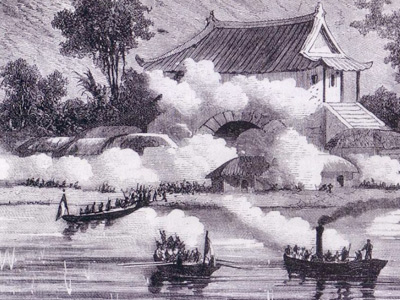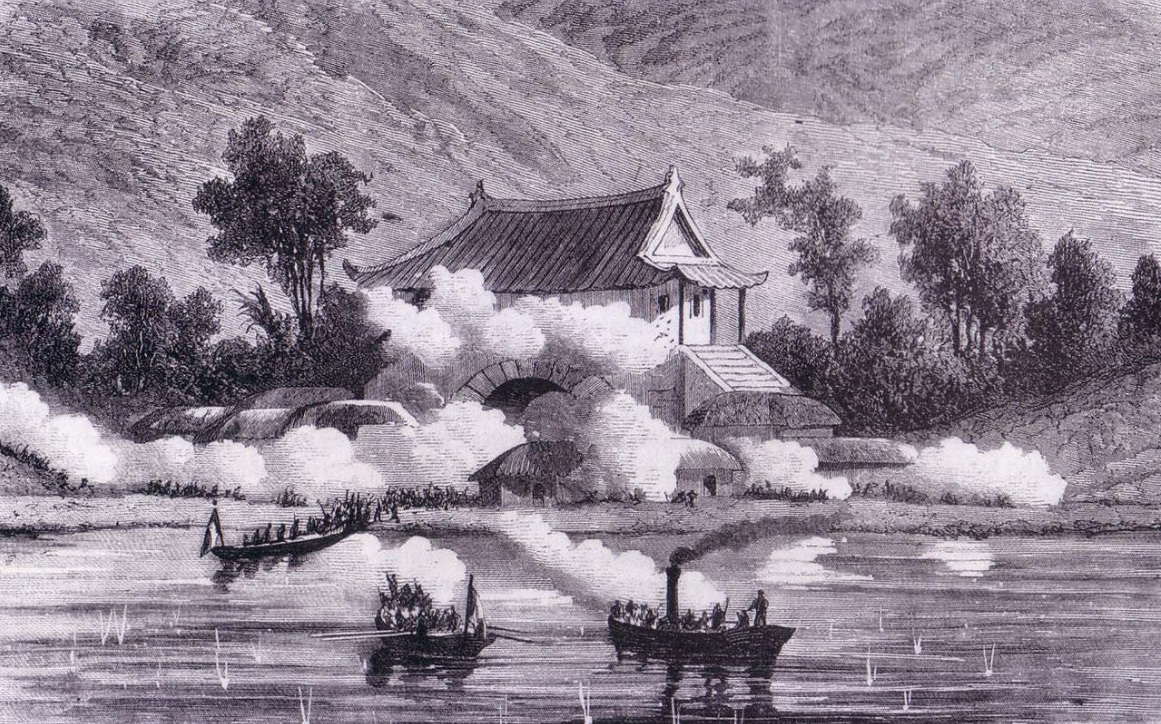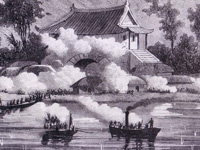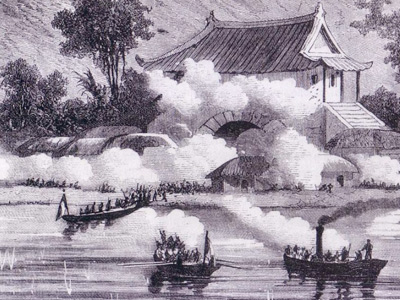French Campaign against Korea 병인양요 (1866)

The French campaign against Korea was an 1866 punitive expedition undertaken by the Second French Empire in retaliation for the earlier Korean execution of several French Catholic missionaries. The encounter over Ganghwa Island lasted nearly six weeks.
The result was a French Second French Empire was the 18-year Imperial Bonapartist regime of Napoleon III from 14 January 1852 to 27 October 1870. The Second Empire is given high credit for the rebuilding of Paris with broad boulevards, striking public buildings, and elegant residential districts for upscale Parisians. In international policy, Napoleon III tried to emulate his uncle Napoleon I, engaging in numerous imperial ventures around the world as well as several wars in Europe. retreat and a check on French influence in the region. The encounter also confirmed Korea in its isolationism for another decade, until Japan
Second French Empire was the 18-year Imperial Bonapartist regime of Napoleon III from 14 January 1852 to 27 October 1870. The Second Empire is given high credit for the rebuilding of Paris with broad boulevards, striking public buildings, and elegant residential districts for upscale Parisians. In international policy, Napoleon III tried to emulate his uncle Napoleon I, engaging in numerous imperial ventures around the world as well as several wars in Europe. retreat and a check on French influence in the region. The encounter also confirmed Korea in its isolationism for another decade, until Japan The Empire of Japan, also known as the Japanese Empire or Imperial Japan, was a historical nation-state and great power that existed from the Meiji Restoration in 1868 until the enactment of the post-World War II 1947 constitution and subsequent formation of modern Japan. Economic and political turmoil in the 1920s led to the rise of militarism, nationalism and totalitarianism eventually culminating in Japan's membership in the Axis alliance. forced it to open up to trade in 1876 through the Treaty of Ganghwa. In Korea it is known as the Byeong-in yangyo, or "Western disturbance of the byeong-in year".
The Empire of Japan, also known as the Japanese Empire or Imperial Japan, was a historical nation-state and great power that existed from the Meiji Restoration in 1868 until the enactment of the post-World War II 1947 constitution and subsequent formation of modern Japan. Economic and political turmoil in the 1920s led to the rise of militarism, nationalism and totalitarianism eventually culminating in Japan's membership in the Axis alliance. forced it to open up to trade in 1876 through the Treaty of Ganghwa. In Korea it is known as the Byeong-in yangyo, or "Western disturbance of the byeong-in year".
Background
Throughout the history of the Joseon Dynasty, Korea maintained a policy of strict isolationism from the outside world (with the exceptions being interaction with the Qing dynasty and occasional trading with Japan through the island of Tsushima). However, it did not succeed entirely in sealing itself off from foreign contact. Catholic missionaires had begun to show an interest in Korea as early as the 16th century with their arrival in China and Japan.

French fleet in Ganghwa, Choseon
Through Korean envoy missions to the Qing court in the 18th century, foreign ideas, including Christianity, began to enter Korea and by the late 18th century Korea had its first native Christians. However, it was only in the mid 19th century that the first western Catholic missionaries began to enter Korea. This was done by stealth, either via the China–North Korea border or the Yellow Sea. These French missionaries of the Paris Foreign Missions Society arrived in Korea in the 1840s to proselytize to a growing Korean flock. Bishop Siméon-François Berneux, appointed in 1856 as head of the infant Korean Catholic church, estimated in 1859 that the number of Korean faithful had reached nearly 17,000.
At first, the Korean court turned a blind eye to such incursions. This attitude changed abruptly, however, with the enthronement of the fourteen-year-old King Gojong in 1864. By Korean tradition, the regency in the case of a minority would go to the ranking dowager queen. In this case, it was the conservative mother of the previous crown prince, who had died before he could ascend the throne. The new king’s father, Yi Ha-ung, a wily and ambitious man in his early forties, was given the traditional title of the unreigning father of a king: Heungseon Daewongun, or “Prince of the Great Court”.
Though the Heungseon Daewongun’s authority at court was not official, stemming in fact from the traditional imperative in Confucian societies for sons to obey their fathers, he quickly seized the initiative and began to control state policy. He was arguably one of the most effective and forceful leaders of the 500-year-old Joseon Dynasty. With the aged dowager regent’s blessing, the Heungseon Daewongun set out upon a dual campaign of both strengthening central authority and Korean isolation from the disintegrating traditional order outside its borders. By the time the Heungseon Daewongun assumed de facto control of the government in 1864, there were twelve French Jesuit priests living and preaching in Korea, and an estimated 23,000 native Korean converts.
In January 1866, Russian Russian Empire was an empire and the final period of the Russian monarchy from 1721 to 1917, ruling across large parts of Eurasia. The rise of the Russian Empire coincided with the decline of neighbouring rival powers: the Swedish Empire, the Polish–Lithuanian Commonwealth, Qajar Iran, the Ottoman Empire, and Qing China. Russia remains the third-largest empire in history, surpassed only by the British Empire and the Mongol Empire. ships appeared on the east coast of Korea demanding trading and residency rights in what seemed an echo of the demands made on China by other western powers. Korean Christians with connections at court saw in this an opportunity to advance their cause and suggested an alliance between France and Korea to repel the Russian advances, suggesting further that this alliance could be negotiated through Bishop Berneux. The Heungseon Daewongun seemed open to this idea, but it was possibly a ruse to bring the head of the Korean Catholic Church out into the open; upon Berneux's arrival to the capital in February 1866, he was seized and executed. A round-up then began of the other French Catholic priests and Korean converts.
Russian Empire was an empire and the final period of the Russian monarchy from 1721 to 1917, ruling across large parts of Eurasia. The rise of the Russian Empire coincided with the decline of neighbouring rival powers: the Swedish Empire, the Polish–Lithuanian Commonwealth, Qajar Iran, the Ottoman Empire, and Qing China. Russia remains the third-largest empire in history, surpassed only by the British Empire and the Mongol Empire. ships appeared on the east coast of Korea demanding trading and residency rights in what seemed an echo of the demands made on China by other western powers. Korean Christians with connections at court saw in this an opportunity to advance their cause and suggested an alliance between France and Korea to repel the Russian advances, suggesting further that this alliance could be negotiated through Bishop Berneux. The Heungseon Daewongun seemed open to this idea, but it was possibly a ruse to bring the head of the Korean Catholic Church out into the open; upon Berneux's arrival to the capital in February 1866, he was seized and executed. A round-up then began of the other French Catholic priests and Korean converts.
Several factors contributed to the Heungseon Daewongun‘s decision to crack down on the Catholics. Perhaps the most obvious was the lesson provided by China, that it had apparently reaped nothing but hardship and humiliation from its dealing with the western powers - seen most recently in its disastrous defeat during the Second Opium War. No doubt also fresh in the Heungseon Daewongun‘s mind was the example of the Taiping Rebellion in China, which had been infused with Christian doctrines. 1865 had seen poor harvests in Korea as well as social unrest, which may have contributed to a heightened sensitivity to the foreign creed. The crackdown may also have been related to attempts to combat factional cliques at court, where Christianity had made some inroads.
As a result of the Korean dragnet, all but three of the French missionaries were captured and executed: among them included Bishop Siméon Berneux, as well as Bishop Antoine Daveluy, Father Just de Bretenières, Father Louis Beaulieu, Father Pierre-Henri Dorie, Father Pierre Aumaître, Father Martin-Luc Huin - all of whom were members of the Paris Foreign Missions Society, and were canonized by Pope John Paul II on 6 May 1984. An untold number of Korean Catholics also met their end (estimations run around 10,000), many being executed at a place called Jeoldu-san in Seoul on the banks of the Han River.
In late June 1866, one of the three surviving French missionaries, Father Félix-Claire Ridel, managed to escape via a fishing vessel, thanks to 11 Korean converts, and made his way to Chefoo (today known as Yantai), China in early July 1866. Fortuitously in Tianjin at the time of Ridel‘s arrival was the commander of the French Far Eastern Squadron, Rear Admiral Pierre-Gustave Roze. Hearing of the massacre and the affront to French national honor, Roze became determined to launch a punitive expedition against Korea. In this, he was strongly supported by the acting French consul in Peking, Henri de Bellonet.
On the French side, there were several compelling reasons behind the decision to launch a punitive expedition. These had to do with the increasing violence against Christian missionaries and converts within the Chinese interior, which after the Second Opium War in 1860 had been opened up to westerners. As Korea was a vassal state of China, the massacre of westerners and Christians in Korea was seen within the context of anti-Western behavior in China by diplomatic and military authorities in the west. Many believed a firm response to such acts of violence was necessary to maintain national prestige and authority.
In response to the event, the French chargé d'affaires in Beijing, Henri de Bellonet, took a number of initiatives without consulting Quai d'Orsay. Bellonet sent a note to the Zongli Yamen threatening to occupy Korea, and he also gave the French Naval Commander in the Far East, rear admiral Pierre-Gustave Roze instructions to launch a punitive expedition against Korea, to which Roze responded : "Since [the kingdom of] Choson killed nine French priests, we shall avenge by killing 9,000 Koreans."
Preliminaries (10 September – 3 October 1866)
Though the French diplomatic and naval authorities in China were eager to launch an expedition, they were stymied by the almost total absence of any detailed information on Korea, including any navigational charts. Prior to the actual expedition, Rear Admiral Roze decided to undertake a smaller surveying expedition along the Korean coast, especially along the waterway leading to the Korean capital of Seoul. This was done in late September and early October 1866. These preliminaries resulted in some rudimentary navigational charts of the waters around Ganghwa Island and the Han River leading to Seoul. The treacherous nature of these waters, however, also convinced Roze that any movement against the fortified Korean capital with his limited numbers and large hulled vessels was impossible. Instead, he opted to seize and occupy Ganghwa Island, which commanded the entrance to the Han River, in the hopes of blockading the waterway to the capital during the important harvest season and thus forcing demands and reparations on the Korean court.
The nature that these demands were to take was never fully determined. In Peking, the French consul Bellonet had made outrageous (and as it turned out unofficial) demands that the Korean monarch forfeit his crown and cede sovereignty to France. Such a stance was not in keeping with the more circumspect goals of Rear Admiral Roze, who hoped to force reparations. In any case, the demands of Bellonet were never officially endorsed by the French government of Napoleon III. Bellonet would later be severely reprimanded for his importunate blusterings.
Expedition (11 October–12 November 1866)
On 11 October, Admiral Roze left Chefoo with one frigate (Guerrière), two avisos (Kien–Chan and Déroulède), two gunboats (Le Brethon and Tardif) and two corvettes (Laplace and Primauguet), as well as almost 300 Naval Fusiliers from their post in Yokohama, Japan. The total number of French troops is estimated at 800. On 16 October, a group of 170 Naval Fusiliers landed on Ganghwa island, seized the fortress which controlled the Han river, and occupied the fortified city of Ganghwa itself. On Ganghwa Island, the Naval Fusiliers managed to seize several fortified positions, as well as booty such as flags, cannons, 8,000 muskets, 23 boxes of silver ingots and few ones of gold, and various lacquer works, jades, and manuscripts and paintings that comprised the royal library (Oikyujanggak) on the island.
From his earlier exploratory expedition, Roze knew it was impossible for him to lead a fleet of limited force up the treacherous and shallow Han River to the Korean capital and satisfied himself instead with a “coup de main” on the coast. On the mainland across the narrow channel from Ganghwa Island, however, the French offensive was met with stiff resistance from the troops of General Yi Yong-Hui, to whom Roze sent several letters asking for reparation, without success. A major blow to the French expedition came on 26 October, when 120 French Naval Fusiliers landed briefly on the Korean mainland in an attempt to seize a small fortification at Munsusansong, or Mt. Munsu Fort. As the landing party came ashore they were met by brisk fire from its Korean defenders.
If the monastery of Munsusansong fell into French hands, the way to Seoul would be open, so, on 7 November, a second landing party was launched by Roze. 160 Naval Fusiliers attacked Munsusansong defended by 543 Korean "Tiger Hunters." Three French soldiers were killed and 36 injured before a retreat was called. Except for continued bombing and surveying activity around Ganghwa and the mouth of the Han River, French forces now largely fortified themselves in and around the city of Ganghwa.
Roze then sent a new letter, asking for the release of the two remaining French missionaries whom he had reason to believe were imprisoned. No answer was forthcoming, but it became clear from activity seen on the mainland across the narrow straits that Korean forces were mobilizing daily. On 9 November, the French were again checked when they attempted to seize a fortified monastery on the southern coast of Ganghwa called Jeongdeung–sa. Here again stiff Korean resistance, coupled by the overwhelming numerical superiority of the Korean defenders, now numbering 10 000 men, forced a French retreat with dozens of casualties but no deaths.
Soon thereafter, with winter approaching and the Korean forces growing stronger, Roze made the strategic decision to evacuate. Before doing so, orders were given to bombard the government buildings on Ganghwa Island and to carry off the varied contents of official storehouses there. It was also learned around this time that the two missing missionaries feared captured in Korea had in fact managed to escape to China. This news contributed to the decision to leave.
All told the French suffered three dead and approximately 35 wounded. In retreating from Korea, Roze attempted to lessen the extent of his retreat by stating that with his limited means, there was little more he could have accomplished, but that his actions would have a dissuasive effect upon the Korean government:
"The expedition I just accomplished, however modest as it is, may have prepared the ground for a more serious one if deemed necessary,... The expedition deeply shocked the Korean Nation, by showing her claimed invulnerability was but an illusion. Lastly, the destruction of one of the avenues of Seoul, and the considerable losses suffered by the Korean government should render it more cautious in the future. The objective I had fixed to myself is thus fully accomplished, and the murder of our missionaries has been avenged." report of 15 November by Admiral Roze
The European residents in China considered the results of the expedition minimal and demanded unsuccessfully a larger expedition for the following spring.
After this expedition, Roze with most his fleet returned to Japan, where they were able to welcome the first French military mission to Japan (1867–1868) in the harbour of Yokohama on 13 January 1867. The French government ordered the military to leave as a result of heavy losses in the French intervention in Mexico.
Seized Korean royal books
The books seized by the French at Ganghwa, some 297 volumes of Uigwe, royal court protocols of Korea's last ruling monarchy, the Joseon dynasty, dating from between the 14th and 19th centuries, went on to become the core of the Korea collection in the Bibliothèque nationale de France. In 2010 it was revealed that the French government was planning to return the books on a renewable lease to Korea, despite the fact that French law generally prohibited the cession of museum property. In early 2011 South Korean president Lee Myung Bak and French president Nicolas Sarkozy finalized an agreement for the return of all the books on a renewable lease. In June 2011 celebrations were held in the port city of Incheon to commemorate their final return. The collection is now being stored in the National Museum of Korea.
HISTORY

RESOURCES
This article uses material from the Wikipedia article "French campaign against Korea (1866)", which is released under the Creative Commons Attribution-Share-Alike License 3.0.
© Stories Preschool. All Rights Reserved.









